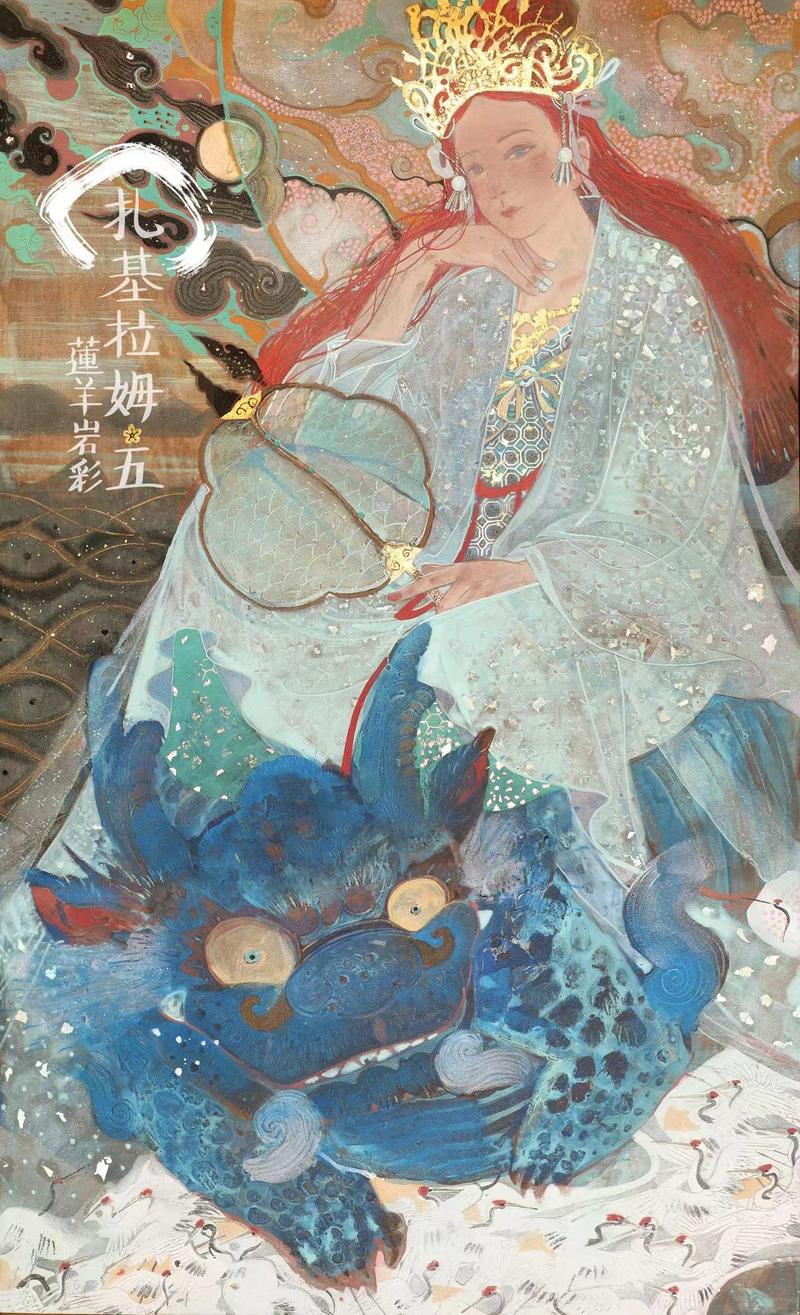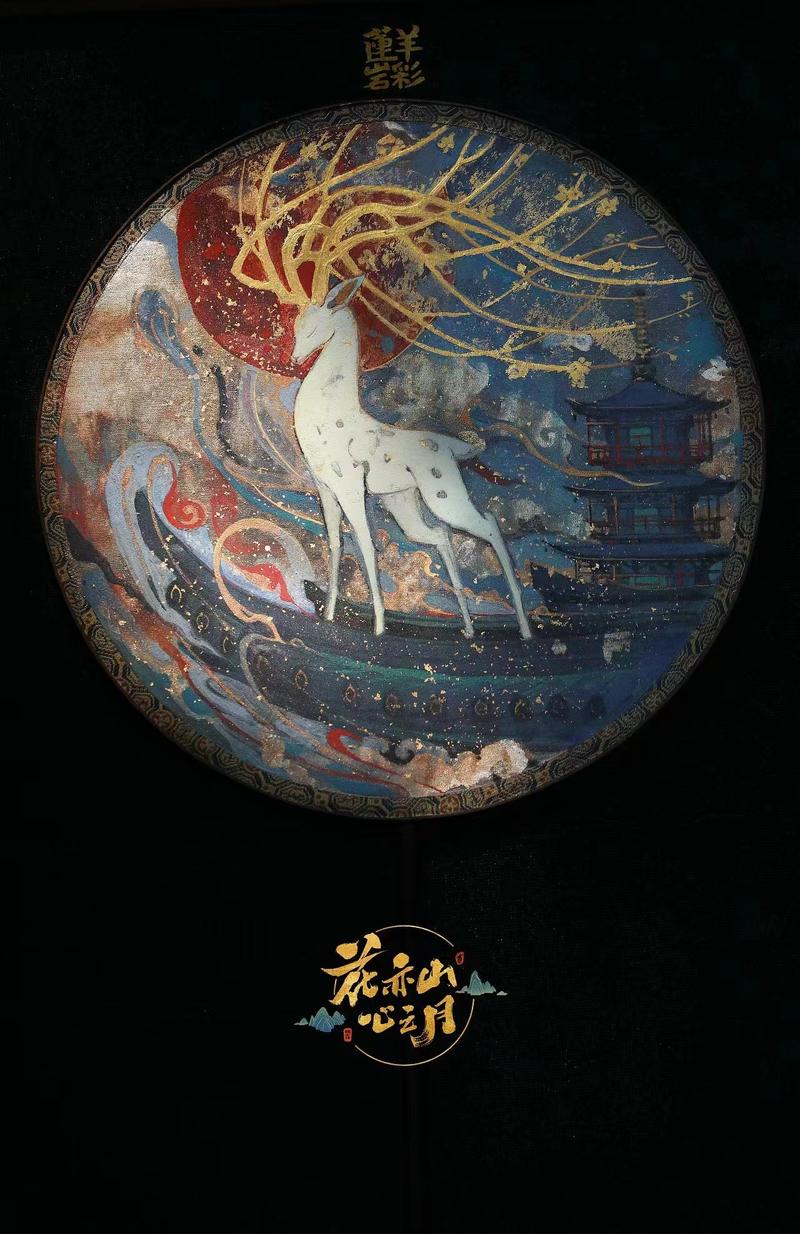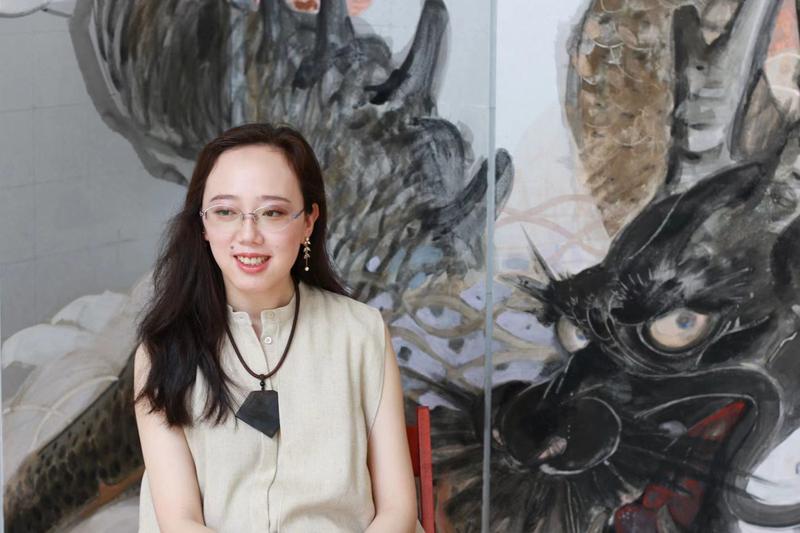Master of minerals Wu Yang's work is inspired by ancient craftsmanship, Xu Haoyu reports.
 Some mineral color paintings created by artist Wu Yang are inspired by deities and creatures from Chinese mythology, as well as Buddhist sutras. (PHOTO PROVIDED TO CHINA DAILY)
Some mineral color paintings created by artist Wu Yang are inspired by deities and creatures from Chinese mythology, as well as Buddhist sutras. (PHOTO PROVIDED TO CHINA DAILY)
Wu Yang, a female artist born after 1985 who graduated from the Central Academy of Fine Arts, is introducing a relatively unknown form-mineral color painting.
Her videos recording the creation process of mineral color painting have received millions of views on Chinese social media platforms. Wu has received recognition from young collectors born after 1985, and even the post-1990 generation, and her works are often sold as early as in the draft stage.
The mineral art has a richness of color that is not found in Chinese painting, but the sense of mystery is very Eastern, which, again, is not found in oil painting.
Wu Yang, artist
Wishing to remind people of the art from the Tang Dynasty (618-907), Wu grinds up minerals to paint deities from Chinese mythology in saturated colors, creating a new style that is both traditional and contemporary.
Wu explains that the mineral color painting could be simply understood as "turning a 1,000-year-old fresco into art on a shelf".
As the pigments, basically minerals and precious stones, are inherently weighty, the canvas has to be supported by a wooden board that is not prone to cracking, yet still malleable, such as cedar. Covering it with the replicated linen paper like that used during the Tang Dynasty, with its thick, absorbent fibers, the canvas is all set.
Once the paper is mounted on the board, which has a light yellow hue, Wu first paints the paper white and grinds shells into powder and lays down a base layer. Then, she grinds the minerals into powder, which she boils into pigment.
Wu claims that creating mineral art is nothing like the painting using normal materials, in which she can simply mix different colored paints to create other shades, because emeralds, for instance, don't work in such a way.
To paint green, Wu applies a thin layer of yellow first and then applies blue on it when it dries; she calls the process "overlaying layers of tulle".
 Some mineral color paintings created by artist Wu Yang are inspired by deities and creatures from Chinese mythology, as well as Buddhist sutras. (PHOTO PROVIDED TO CHINA DAILY)
Some mineral color paintings created by artist Wu Yang are inspired by deities and creatures from Chinese mythology, as well as Buddhist sutras. (PHOTO PROVIDED TO CHINA DAILY)
Usually, the canvas gets thicker while she paints-the more mineral material that's added, the more three-dimensional the painting becomes. The layers get even more richly decorated with line carving and gold foil.
"The mineral art has a richness of color that is not found in Chinese painting, but the sense of mystery is very Eastern, which, again, is not found in oil painting," she says.
Looking at it from different angles and in different lights, the modern mineral color painting shines fully, with sparkle and texture.
The edges and corners of the minerals' coarse grains are visible to the naked eye and, under light, it forms a visually striking surface, like a starry river.
Wu mentions that, if kept correctly without soaking or prolonged exposure to the sun, mineral art can last for hundreds of years. It's a gift of nature which is environmentally friendly.
She reveals that the cyan and red are the most expensive pigments, as you can rarely find natural minerals in these colors. Beautiful minerals, such as malachite and lapis lazuli, are highly priced and usually used in jewelry.
Luckily, in recent times, in response to the increasing scarcity or prohibition of natural ores, new materials have been developed as artificial ores are smelted by dissolving glazes and metal oxides. This method has expanded her color pallette from just a few dozen to several thousand.
Also, Wu likes to pick up beautiful stones while enjoying the outdoors, and she's always excited about powdering them and finding out what color they will turn into.
She's now very familiar with the formation conditions of various minerals. For instance, where there are volcanoes there is sulfur and where there are caves there are crystals.
Wu usually draws inspiration from traditional culture, including ancient landscape paintings, books like The Classic of Mountains and Seas and Buddhist sutras. She later traveled around exploring the old art pieces following the path taken by Tang Dynasty monk Xuanzang to Northwest China and Gansu province's Dunhuang. In her eyes, those are the stories worth telling.
 Some mineral color paintings created by artist Wu Yang are inspired by deities and creatures from Chinese mythology, as well as Buddhist sutras. (PHOTO PROVIDED TO CHINA DAILY)
Some mineral color paintings created by artist Wu Yang are inspired by deities and creatures from Chinese mythology, as well as Buddhist sutras. (PHOTO PROVIDED TO CHINA DAILY)
Born in Dazhou city, Sichuan province, Wu started drawing when she was around 3 years old. She would use the coloring pens her mother, a teacher, kept to mark homework. She loved to use them to scribble on the walls or her clothes. Wu's open-minded parents never got cross with her for the mess she created, but instead saw her potential, buying her paper and pens of her own so that she could pursue her passion.
Wu later enrolled in Sichuan Fine Art Institute in Chongqing, before going on to study computer graphics at the Central Academy of Fine Arts in Beijing. There she learned important skills, such as how to create art pieces combining ink painting and Photoshop.
After graduating in 2008, Wu worked as clerical administrative staff at the Ministry of Culture in Beijing, but she didn't put down her brushes. She spent her spare time creating illustrations and graphic designs for fun and also taking orders from publishers, game companies and film advertising companies.
Wu quit her job in 2011, when she gradually realized that digital painting might replace hand-drawn art.
She reveals that, for three years, she learned basic skills like sketching, but people now only need to put a photo into some computer software and it can immediately be rendered as an oil painting or watercolor.
"I felt my presence getting weaker," Wu says. However, the feeling of powerlessness didn't tear her apart, but instead strengthened her determination to find an artistic expression that couldn't be replaced so easily by modern technology.
In 2012, Wu started her own art studio in Beijing and became a full-time artist.
In the early stages of her venture, Wu explored Chinese ink painting, with dragons as the main theme.
As an artist who has been watching dragon-related TV and movies, as well as admiring graffiti, since childhood, she is strongly attracted by dragon iconography.
In her early 20s, Wu drew dozens of dragons in one year, each with its own name, and her fans online called her "the youngest dragon-themed artist".
 Wu Yang, artist. (PHOTO PROVIDED TO CHINA DAILY)
Wu Yang, artist. (PHOTO PROVIDED TO CHINA DAILY)
One of her creations named Long Si won her the Special Jury Prize at the 13th Barcelona International Comic Festival in 2012. The series was published as a picture book in the same year.
Out of the blue, Wu switched focus to mineral color painting, which seemed to be a move that ditched the accumulation of the past. But, in fact, she has always been pursuing an artistic expression that keeps up with the times and suits herself, as well as not being limited to just painting.
Wu visited Jingdezhen, a city in Jiangxi province, known as "the capital of porcelain", famous for its blue and white ceramics. However, she always felt unsatisfied artistically, until she saw the Dunhuang frescoes.
The artist first approached mineral color painting in 2013, when there were no related majors in China. She studied the Dunhuang frescoes and ancient architecture instead. While most of her early research came from text and pictures, much of the information was incomplete, so she felt driven to look for professional education.
In China, mineral color painting flourished during the Tang Dynasty and Five Dynasties and Ten Kingdoms (907-960) and was used extensively in art forms such as murals, screens and statues. In the late Yuan Dynasty (1271-1368), as literati ink painting caught people's attention, the popularity of mineral color painting gradually waned in the central regions of China. However, after it spread to Japan, it was passed on and developed, according to Wu.
To learn the technique and get to know the art more deeply, Wu left Beijing in 2015 and took a master's course at Tama Art University in Tokyo. She learned about pigments, the modernization of mineral color painting and paper restoration, and never lost the desire to bring the forgotten art of China back home.
During her studies, she posted her process of learning and creating mineral art on social media platforms in China, and an increasing number of people began to take notice of Wu-known as Lianyang online-and her work.
Facing the criticism of "over-commercialization", Wu never considers commercial collaborations as a wrong choice. She believes that access to galleries and auctions is still not broad enough, and mineral color art could be trapped in an ivory tower.
"That's why I've crossed over with different industries, such as games, publishing and advertising, so that mineral color can 'break the circle' as quickly as possible, and more people, especially youths, can get to know it and see the many possibilities for its application," Wu says.
Wu formed a social group, and she has made mineral color painting known to more people through livestreamed lectures, a series of video courses, and in-person workshops.
One of Wu's videos received over 7 million views on Bilibili, a video-sharing platform in China, and gathered more than 20 million views across all online social media platforms.
She explains that people cannot see many of the details in a mineral color painting by looking at pictures, so she posted videos that recorded her painting process online, and gradually they began to receive massive attention.
"In recent years especially, the wave of cultural confidence and the national trend is encouraging the inheritance and innovation of traditional Chinese culture. I really look forward to seeing mineral color painting reach more people by riding that wave," she says, adding that she hopes she's always moving forward, directed by the trends and the times.
Contact the writer at xuhaoyu@chinadaily.com.cn


